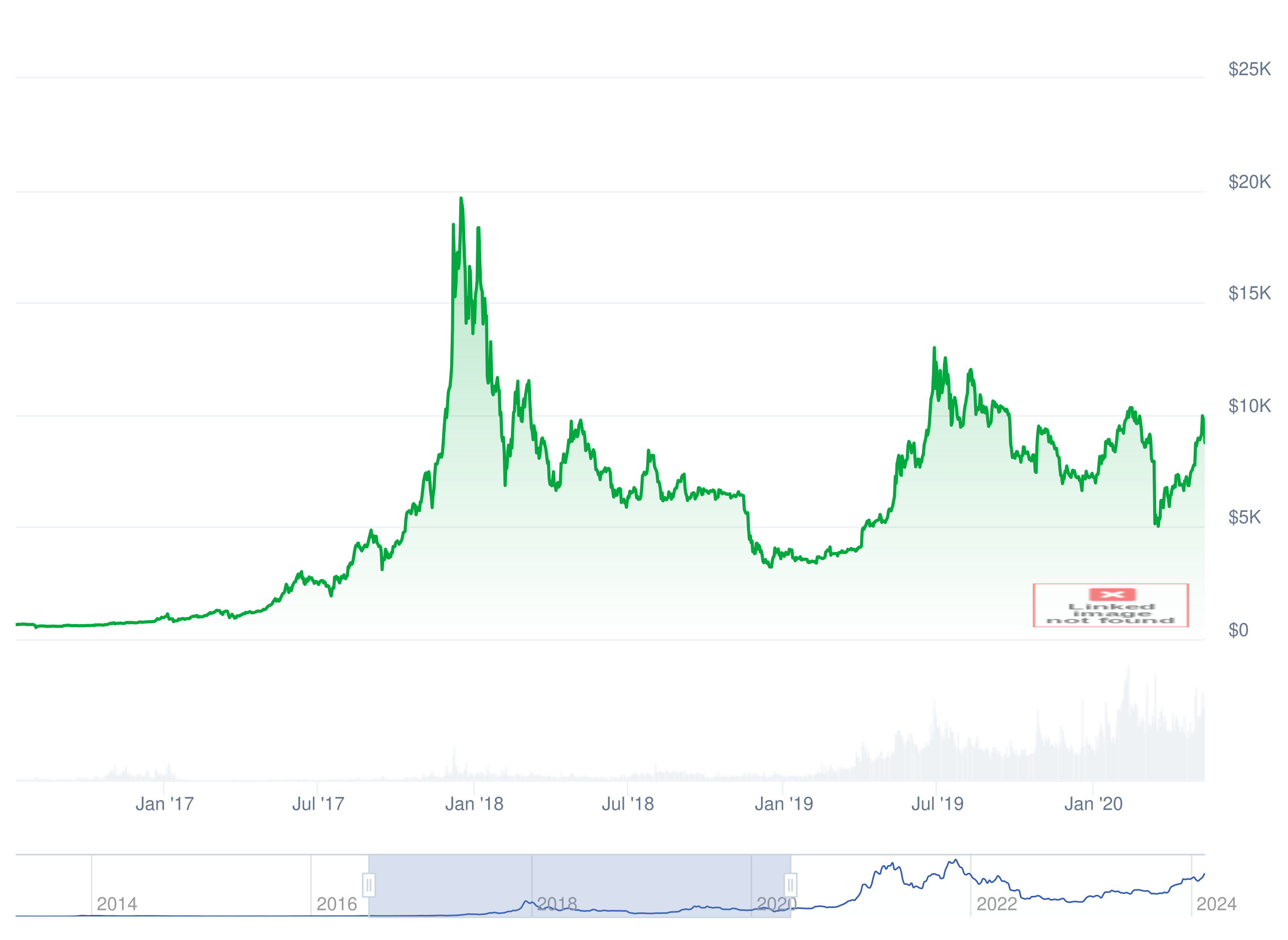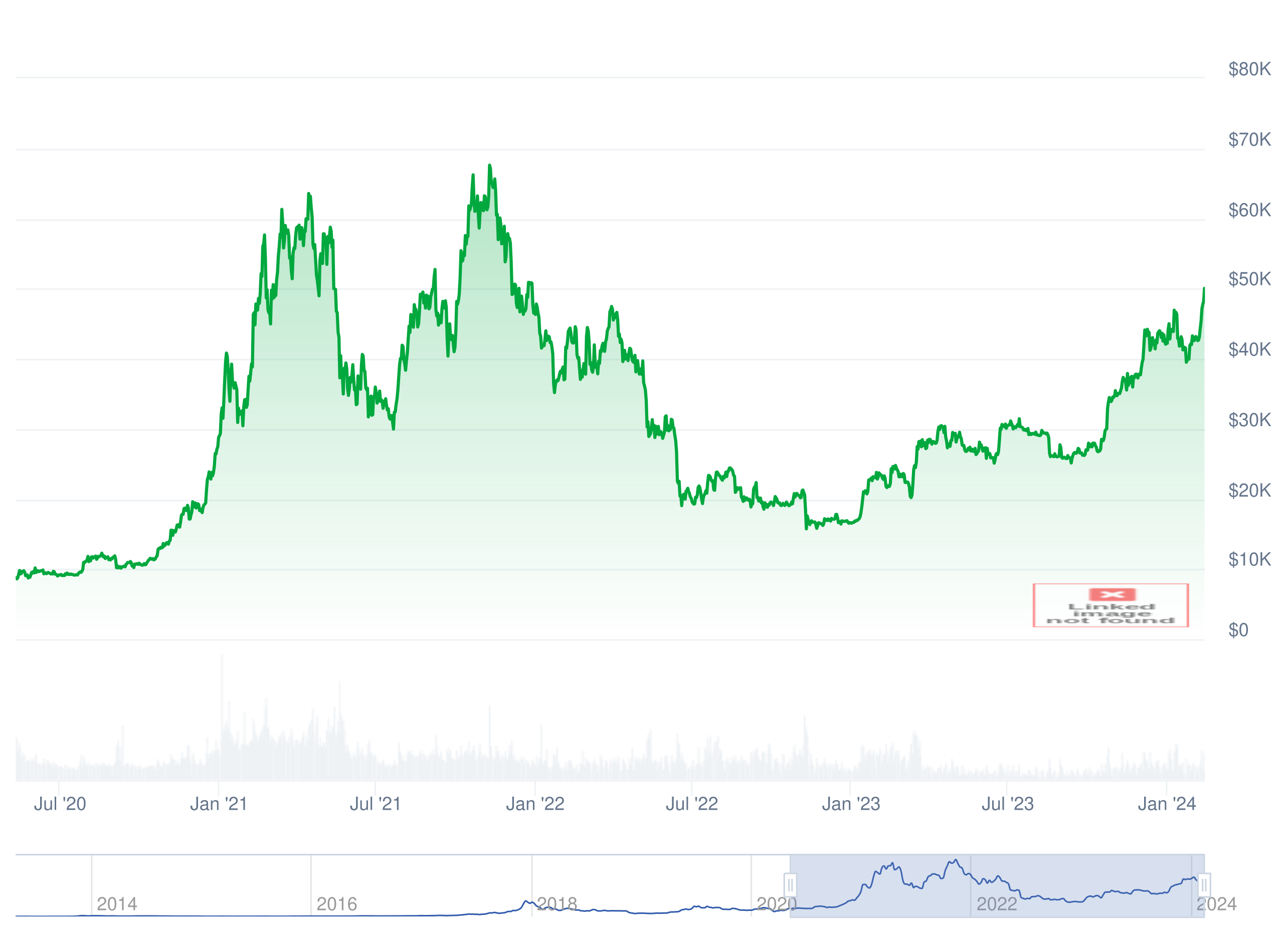
Contents
The fabled Bitcoin halving is only a couple of months away. You know what they say: this event marks the beginning of a very wild time in the crypto market! Aren’t sure how and what does it mean? We have got you covered: learn how Bitcoin market cycles work and find some insightful next crypto bull run predictions in our new article.
Disclaimer
This article is not a piece of financial or investment advice. When dealing with cryptocurrencies, remember that they are extremely volatile and thus, a high-risk investment. Always make sure to stay informed and be aware of those risks. Consider investing in cryptocurrencies only after careful consideration and analysis of your own research and at your own risk.
Key Takeaways
- The phrase “Bitcoin bull run” usually refers to a parabolic rally that culminates in 12 to 18 months after the Bitcoin halving. More broadly, it is used to talk about the period that precedes the peak, during which the prices of cryptocurrencies steadily grow.
- The high confidence in the occurrence of such a rally after the April 19, 2024 Bitcoin halving comes from the fact that the previous halvings were also followed by these price surges. If a similar pattern occurs this time as well, the price of Bitcoin should peak between April and October 2025.
- The Bitcoin halving and the next crypto bull run is such an anticipated event because the rest of the crypto market gets to enjoy the same meteoric growth and even outperform Bitcoin. There is no guaranteed winner among altcoins yet for obvious reasons but there are quite a few candidates.
What Defines a BTC Bull Run?
Of course, Bitcoin and crypto bull run is a you-know-when-you-see-it thing but for this article, let’s clear up the terms we are going to rely on heavily. In finance, a bull run is another way to refer to a long-term rally or upward trend. The economic growth during 2009–2019 has been referred to as such, so a bull run theoretically can last for a whole decade and start relatively low.
In the crypto sphere, a bull run is a more concrete and predictable occasion. The crypto market and Bitcoin in particular have shown cyclical behavior, reminiscent of economic bubbles. The growth phase, which usually has a set start, is known as the Bitcoin bull run. Alternatively, people use this to refer to a more prominent phase of price growth, which has so far culminated in new price records for Bitcoin and other cryptos.
The start of the bull run or at the very least, the point of reference, is the Bitcoin halving. This programmatic event, hard-coded into the Bitcoin protocol to occur roughly every four years, slashes the mining rewards in half, hence the name. The logic behind this may seem counterintuitive at first: if miners, who secure the blockchain, receive less, aren’t they going to leave, making the network less stable? However, the more important effects of the halving event are observed in the longer term: the issuance rate of BTC slows down, it gets scarcer, and soars in price.
Bitcoin’s Historical Trends
Bitcoin has been up and running since 2009, so by now there is quite a lot of price history to work with for historical analysis. The halving theory is grounded in exactly that, and time is proving once and again that there is some substance to it. Let’s briefly review the previous and current market cycles to see for ourselves.
2016–2020 Cycle

To see if the market cycles are indeed connected with the halving dates, let’s check BTC’s price history between the 2016 and 2020 halvings. Some of it coincides with a classic bubble pattern and some part decouples from it.
Before the early 2018 price peak, we can clearly see a parabole. For about a year since the halving on July 9, 2016, the BTC price has been on a relatively slow upward trend. Arguably, the phase of clear growth might have started in early 2017.
During that year, the growth of BTC accelerated and culminated in early 2018. From there, the price corrects sharply, as the selloff starts. In a bubble, this phase is called the burst. What follows is a cool-off phase, characterized by a steady long-term downward trend, although every now and then the bulls attempt to lift BTC from the bottom.
2019 became known in the crypto world as the “crypto winter”. Although it certainly had its ups and downs, it was not entirely an accumulation phase, if it were a classic bubble. From the new bottom near $3–4K, it managed to grow to almost $13 thousand in a few months, and the trading volumes grew steadily to levels even above the 2018 peak.
2020–2024 Cycle

So far, we can see that the BTC price trends since the 2020 halving follow a similar pattern. Even though the crypto industry is starkly different from what it was like four years ago.
Some of the key factors behind the charts being different are the market capitalization and the aforementioned volume growth. With the growth in acceptance from institutional investors, Bitcoin became more frequently traded and responsive to price changes.
This time around, the accumulation phase before and after the 2020 halving on May, 11 lasted for about fifteen months. If not for the almost 50% price drop in March 2020, when the COVID-19 pandemic officially began, this growth phase would have been smoother. Nevertheless, by January 2021, exactly three years after the previous bull run, BTC was worth over $30 thousand.
But it did not stop there: the rally extended into April 2021, when Bitcoin reached a new record above $60 thousand. Although not enough time had passed since the halving, the price returned to $30K. Bitcoin investors’ confidence in the halving theory and a sharp pullback on a greedy market helped it go back up and finally arrive at the current ATH of $69,044.77.
Once again, late 2021 and the following year saw a turn to a strong downtrend. It was a tumultuous time in the crypto market, as the projects that built up value on the bull market failed to adapt to the bearish one. 2023, in turn, amalgamated the accumulation phase with a renewed uptrend. It seems that the Bitcoin market bottomed out in November 2022, so more buyers have been coming to prepare for the coming crypto bull run. The upcoming crypto bull run seems to be inevitable at this point, and the only question is when is it coming.
When is the next crypto bull run?
The miner rewards for producing Bitcoin blocks are to be slashed from 6.25 BTC to 3.125 BTC on the block 840,000. The estimated date, provided the target time of 10 minutes is consistently met, is on April 19, 2024. At least the reference point to start the bull run countdown is more or less predictable!
So far, observations have shown that the Bitcoin price peaks from 368 to 550 days after the halving. Should Bitcoin repeat the same patterns, we can expect a new price record sometime between April 22 and October 21, 2025.
In other words, the next bull run is slated for 2025. Of course, to some effect, the rally across the cryptocurrency market is expected to start later this year. And besides, it wouldn’t hurt to keep in mind that past performance does not guarantee future results.
2025 Crypto Bull Run Prediction
Bull Run Catalysts to Watch Today
Previous cycles were influenced by narratives and events that boosted the price. It is more or less clear with the news but how do narratives play into it? The atmosphere of greed and FOMO has the power to affirm the crypto investors that they made the right call and that the future, which is the current trend with this demographic, is around the corner. Perhaps, it is more likely that the relationship between price action and bullish news was a more complex one, with both factors influencing each other in a feedback loop.
For example, after the first halving in 2012, some mainstream media attention was enough to attract enough retail investors who fuelled the rally. The 2017 rally was accelerated by the growth of the Ethereum ecosystem and the “ICO boom”. In 2021, things like the metaverse and NFTs were breaking into the mainstream.
Which trends of 2024 are already driving the crypto market up? The most obvious one is Bitcoin ETFs. We have already seen how rising volumes helped extend the bull rally in 2021, which came from retail and pros alike. Experts also believe that Ethereum can help fuel the current rally as well, with more DeFi and tokenization products, and the prospects of improving scalability on the horizon. The metaverse, NFTs, Web3, and GameFi are sometimes cited as possible catalysts but these were around in 2021, too, and their current state is far from the red-hot buzzwords they were back then.
What you should watch intently is the artificial intelligence (AI) scene, although it might not necessarily be a catalyst. From hardware to capital, AI advancements take up resources from companies in the tech industry, which in the previous cycle would end up in crypto. Unless there is a way to combine the best of both worlds, AI could take away the spotlight from Web3, new types of crypto tokens such as real-world assets, or whatever else crypto comes up with in 2024.
How High Can the Crypto Market Go?
Another question on everyone’s minds is not when but how high. After all, at this point, a crypto bull run is thought of as almost a certainty. Industry insiders and experts almost seem to try to one-up each other giving extremely bullish Bitcoin price predictions for the upcoming bull run.
In 2022, Pantera Capital shared insights into the impact of Bitcoin halving from the efficient markets theory’s point of view. It postulates that events that everyone sees coming are priced in, so the path to their target of $148,636 is all but set in stone.
A longtime Bitcoiner Tuur Demeester believes trillions of dollars that entered circulation as bailouts and stimulus will help carry BTC to $200–600K. Although, he admits cycles may break in the long run and the peak may come even later than expected.
Billionaire investor and early Bitcoin adopter Tim Draper envisions hyperbitcoinization coming, which will easily make its price $250K in a few years. However, he has stuck to this target for years at this point.
The ChangeHero team previously made a forecast that the BTC bull run could extend to $103,322 at the peak. Please note that this estimate was made with huge assumptions about the extent of the rally and should be thought of as an estimate rather than a target.
Another tool that is used for estimating the extent of the bull run is the Bitcoin rainbow chart. Using this tool, your estimate for the price of BTC a year after the halving if it performed like in the previous cycle would land between $150K and $200K. Hold off on getting too pumped up about this forecast: the caveat here is that the rainbow chart is a tool for historical analysis and proof of the halving theory.
Which Cryptocurrencies Can Win This Time?
Not only Bitcoin maxis are anticipating the big surge. Altcoiners are looking forward to it even more! Bitcoin is a good bet in any case but holders who can handle higher risks for more returns can start choosing a blue chip to wager on. As we found in the guide we mentioned, dedicating even 10% to the right asset can supercharge your portfolio’s performance without putting it all at risk. Which altcoin can do it this time is a whole other question that we will now try to answer anyway.
Before focusing on smaller caps, it bears mentioning that by now, Ethereum (ETH) has solidified its place in any portfolio. It may not be as recognized as Bitcoin but it is second to BTC only, and its prospects of development and performance are arguably better.
Zooming out to look at the top ten, XRP seems to be in a good place now with the SEC v. Ripple case good as closed. In the past cycle, it grew by over 1,000% from the March bottom to the peak. Cardano (ADA) and Solana (SOL) are decent alternatives with similar prospects.
Among the newer coins that have not yet gone through a full market cycle Toncoin (TON) and Optimism (OP) deserve attention. After all, it does not seem that Ethereum L2s or alternative smart contract platforms will become obsolete by 2025. More coins similar to those are Arbitrum (ARB) and SUI.
Another idea is to review the narratives of today and try to evaluate how likely it is for them to stay relevant in 2025. Do you feel an NFT revival coming? The BLUR token may be worth checking out. The AI industry seems to be here to stay, so tokens like Render (RNDR) and The Graph (GRT) could do well. Now that there are even more institutional investors and Wall Street money in crypto with Bitcoin ETFs, intel providers like Arkham (ARKM) will carve a niche for themselves in the crypto space.
Conclusion
In any case, as always, the more unstable the cryptocurrency market is, the higher the chance of the most unexpected occurring. A crypto bull run and the height of the crypto bull market is by no means a normal time: prepare for technical difficulties, price fluctuations, and FUD and FOMO galore. Expect the unexpected, as it were, and luckily, there is still some time left for you to prepare.
How do you feel about our predictions? Let us know in the comments on our blog or social media: Twitter, Facebook, and Telegram.
Frequently Asked Questions
When will the crypto bull run start? Will the crypto bull run start in 2024?
There are diverging viewpoints on the question of when the bull market starts in crypto. There is only one known reference point, the Bitcoin halving, expected on April 19, 2024, and some believe it to be the start. Others would say the BTC price will be in accumulation for another year, and there is also the opinion that it has already begun.
What crypto to buy for the next bull run? Which crypto will explode in the next bull run?
In the Bitcoin bull run, most cryptocurrencies experience a price surge, and the only difference is the extent of their rallies. Some of the ChangeHero team’s picks for the BTC bull run 2025 are BTC, ETH, XRP, ADA, SOL, TON, OP, ARB, SUI, BLUR, RNDR, GRT, and ARKM. Please remember that these ideas do not constitute investment or financial advice.
Will there be another crypto bull run?
The prevalent theory about the market cycles of Bitcoin connects them to the halving events, which occur roughly every four years. Since these cycles have so far happened as expected, at this point, there is a firm belief that this time will be no different.
What year is the next bull run in crypto?
Applying historical analysis and date ranges from the previous BTC rallies, the next bull run is estimated to peak in April to October 2025. Remember that this is grounded in an assumption that BTC will repeat past patterns, although the current circumstances around this market are vastly different.
Is 2024 a bull market? Will there be a crypto bull run in 2024?
Even though the BTC bull market is estimated to peak in 2025, by then, its price will experience accelerating, parabolic growth. If this comes to pass this time as well, it is safe to assume that in 2024 the climate on the crypto market will be bullish.






